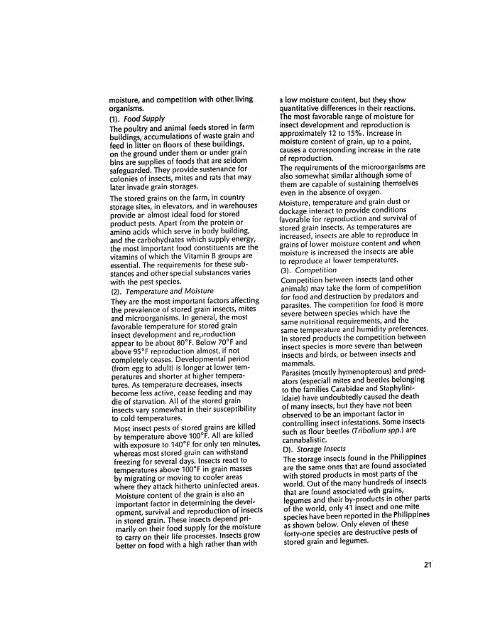I AR Pest control - USAid
I AR Pest control - USAid
I AR Pest control - USAid
Create successful ePaper yourself
Turn your PDF publications into a flip-book with our unique Google optimized e-Paper software.
moisture, and competition with other,living<br />
organisms.<br />
(1). Food Supply<br />
The poultry and animal feeds stored in farm<br />
buildings, accumulations of waste grain and<br />
feed in litter on floors of these buildings,<br />
on the ground under them or under grain<br />
bins are supplies of foods that are seldom<br />
safeguarded. They provide sustenance for<br />
colonies of insects, mites and rats that may<br />
later invade grain storages.<br />
The stored grains on the farm, in country<br />
storage sites, in elevators, and in warehouses<br />
provide ar almost ideal food for stored<br />
product pests. Apart from the protein or<br />
amino acids which serve in body building,<br />
and the carbohydrates which supply energy,<br />
the most important food constituents are the<br />
vitamins of which the Vitamin Bgroups are<br />
essential. The requirements for these substances<br />
and other special substances varies<br />
with the pest species.<br />
(2). Temperature and Moisture<br />
They are the most important factors affecting<br />
the prevalence of stored grain insects, mites<br />
and microorganisms. In general, the most <br />
favorable temperature for stored grain <br />
insect development and redroduction <br />
appear to be about 80'F. Below 70'F and <br />
above 95'F reproduction almost, if not <br />
completely ceases. Developmental period <br />
(from egg to adult) islonger at lower tem-<br />
peratures and shorter at higher tempera-<br />
tures. As temperature decreases, insects <br />
become less active, cease feeding and may <br />
die of starvation. All of the stored grain <br />
insects vary somewhat in their susceptibility <br />
to cold temperatures. <br />
Most insect pests of stored grains are killed <br />
by temperature above 100'F. All are killed <br />
with exposure to 140'F for only ten minutes,<br />
whereas most stored grain can withstand<br />
freezing for several days. Insects react to<br />
temperatures above 1000F in grain masses<br />
by migrating or moving to cooler areas<br />
where they attack hitherto uninfected areas.<br />
Moisture content of the grain isalso an<br />
important factor in determining the development,<br />
survival and reproduction of insects<br />
in stored grain. These insects depend primarily<br />
on their food supply for the moisture<br />
to carry on their life processes. Insects grow<br />
better on food with a high rather than with<br />
a low moisture content, but they show<br />
quantitative differences in their reactions.<br />
The most favorable range of moisture for<br />
insect development and reproduction is<br />
approximately 12 to 15%. increase in<br />
moisture content of grain, up to apoint,<br />
causes a corresponding increase in the rate<br />
of reproduction.<br />
The requirements of the microorganisms are<br />
also somewhat similar although some of<br />
them are capable of sustaining themselves<br />
even in the absence of oxygen.<br />
Moisture, temperature and grain dust or<br />
dockage interact to provide conditions<br />
favorable for reproduction and survival of<br />
stored grain insects. As temperatures are<br />
increased, insects are able to reproduce in<br />
grains of lower moisture content and when<br />
moisture isincreased the insects are able<br />
to reproduce at lower temperatures.<br />
(3). Competition<br />
Competition between insects (and other<br />
animals) may take the form of competition<br />
for food and destruction by predators and<br />
parasites. The competition for food is more<br />
severe between species which have the<br />
same nutritional requirements, and the<br />
same temperature and humidity preferences.<br />
In stored products the competition between<br />
insect species is more severe than between<br />
insects and birds, or between insects and<br />
mammals.<br />
Parasites (mostly hymenopterous) and predators<br />
(especiall mites and beetles belonging<br />
to the families Carabidae and Staphyliniidaie)<br />
have undoubtedly caused the death<br />
of many insects, but they have not been<br />
observed to be an important factor in<br />
<strong>control</strong>ling insect infestations. Some insects<br />
such as flour beetles (Tribolium spp.) are<br />
cannabalistic.<br />
D). Storage Insects<br />
The storage insects found in the Philippines<br />
are the same ones that are found associated<br />
with stored products in most parts of the<br />
world. Out of the many hundreds of insects<br />
that are found associated wth grains,<br />
legumes and their by-products in other parts<br />
of the world, only 41 insect and one mite<br />
species have been reported in the Philippines<br />
as shown below. Only eleven of these<br />
forty-one species are destructive pests of<br />
stored grain and legumes.<br />
21

















